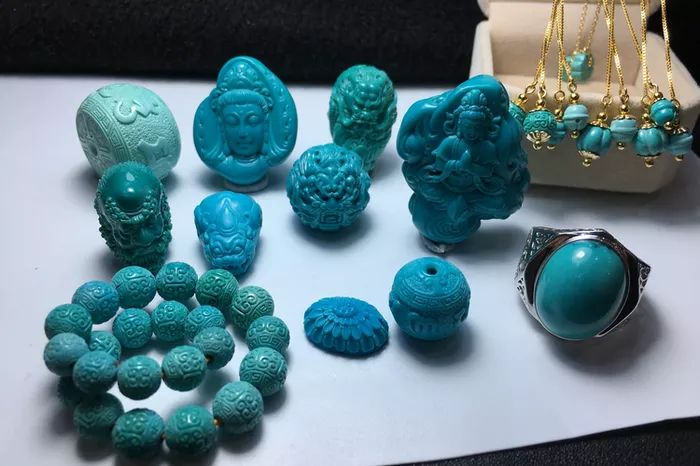Spiny Oyster Turquoise is a unique and vibrant composite material that marries the beauty of two natural treasures: turquoise and spiny oyster shell. This blend results in strikingly colorful and distinctive pieces used in jewelry and decorative arts. Understanding the process of creating Spiny Oyster Turquoise involves exploring both the materials and the methods used to combine them. In this article, we will delve into the origins, characteristics, and manufacturing process of Spiny Oyster Turquoise.
Origins of Spiny Oyster Turquoise
Turquoise: A Timeless Gemstone
Turquoise is a hydrated phosphate of copper and aluminum that has been treasured for millennia. Its sky-blue to green hues have made it a favorite among artisans and jewelers. Turquoise deposits are found in regions such as Iran, the southwestern United States, and Egypt, with each location producing stones with unique characteristics.
Spiny Oyster Shell: A Marine Marvel
Spiny oyster shells come from a species of mollusk known as Spondylus. These shells are found in the warm waters of the Gulf of California and along the coasts of Central and South America. The shells are renowned for their vivid colors, ranging from deep reds and purples to bright oranges and yellows. The spines on these shells, which give them their name, are removed during processing, leaving behind a smooth and colorful material.
Characteristics of Spiny Oyster Turquoise
Color and Appearance
The most striking feature of Spiny Oyster Turquoise is its color palette. The combination of turquoise’s blues and greens with the vibrant hues of spiny oyster shell creates a kaleidoscope of colors. Each piece is unique, with no two composites looking exactly the same. This uniqueness makes Spiny Oyster Turquoise highly sought after in the world of jewelry and decorative arts.
Durability and Strength
While both turquoise and spiny oyster shell are relatively soft materials, when combined, they form a more durable composite. The process of stabilizing and binding these materials together enhances their strength, making them suitable for various applications, including rings, pendants, and inlays.
The Manufacturing Process of Spiny Oyster Turquoise
Sourcing the Materials
The first step in creating Spiny Oyster Turquoise is sourcing high-quality turquoise and spiny oyster shells. Turquoise is often selected for its color and clarity, while spiny oyster shells are chosen based on their vibrant hues and structural integrity. Ethical sourcing practices are crucial to ensure the sustainability and environmental responsibility of the materials used.
Preparation of the Materials
Turquoise Preparation
Cutting and Shaping: Raw turquoise stones are cut into smaller, workable pieces. These pieces are then shaped and polished to enhance their natural beauty.
Stabilization: Turquoise is often stabilized to improve its durability. This involves impregnating the stone with a clear resin, which fills the pores and strengthens the material. Stabilized turquoise is less prone to cracking and discoloration, making it ideal for use in composites.
Spiny Oyster Shell Preparation
Cleaning and Trimming: The spiny oyster shells are thoroughly cleaned to remove any organic material and debris. The spines are trimmed off, leaving a smooth surface.
Slicing and Shaping: The shells are sliced into thin, workable pieces. These slices are then shaped and polished to reveal their vibrant colors.
Combining the Materials
Design and Layout: The prepared pieces of turquoise and spiny oyster shell are arranged in a design that maximizes the visual appeal of the final product. This step requires a keen eye for color and pattern.
Bonding: The arranged pieces are bonded together using a high-quality epoxy resin. The resin not only acts as an adhesive but also fills any gaps between the materials, creating a seamless composite. This bonding process is crucial for the durability and longevity of the finished product.
Curing and Finishing
Curing: The bonded composite is left to cure for a specified period, allowing the resin to harden and set. This ensures a strong bond between the turquoise and spiny oyster shell.
Cutting and Shaping: Once cured, the composite is cut into desired shapes and sizes. This step requires precision to ensure that the final pieces are suitable for use in jewelry or other applications.
Polishing: The cut pieces are polished to a high shine, enhancing the colors and patterns of the composite. Polishing also smooths any rough edges, making the material comfortable to wear as jewelry.
Quality Control
Each piece of Spiny Oyster Turquoise undergoes rigorous quality control checks to ensure it meets the highest standards. This includes inspecting the bond strength, color consistency, and overall appearance. Only pieces that pass these checks are deemed suitable for sale.
See Also: What Is a Boho Turquoise Ring?
Applications of Spiny Oyster Turquoise
Jewelry
Spiny Oyster Turquoise is primarily used in jewelry, where its vibrant colors and unique patterns make it a popular choice. It is crafted into rings, earrings, pendants, and bracelets. Artisans often set the composite in silver or gold to enhance its beauty and create striking contrast.
Decorative Arts
Beyond jewelry, Spiny Oyster Turquoise is also used in various decorative arts. It can be inlaid into furniture, used in mosaics, or crafted into small decorative objects. Its unique appearance makes it a favorite among collectors and artists.
Cultural Significance
In addition to its aesthetic appeal, Spiny Oyster Turquoise holds cultural significance, particularly among Native American artisans in the southwestern United States. The material is often used in traditional jewelry and ceremonial objects, reflecting a rich heritage and deep connection to the natural world.
Conclusion
Spiny Oyster Turquoise is a testament to the beauty that can be achieved by combining two distinct natural materials. The process of creating this composite material involves careful sourcing, preparation, and bonding of turquoise and spiny oyster shell. The result is a vibrant and durable material that is highly prized in jewelry and decorative arts. Understanding the intricate steps involved in making Spiny Oyster Turquoise not only enhances our appreciation for this unique composite but also highlights the skill and craftsmanship required to produce it.


